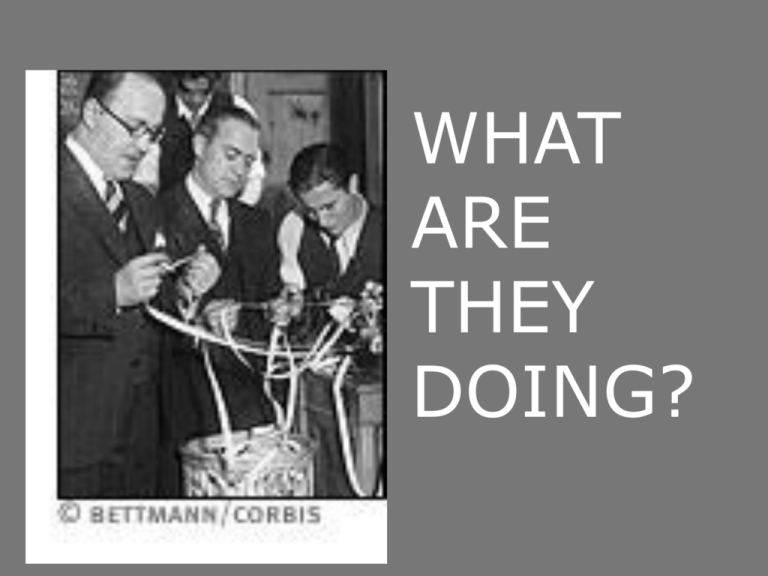
WHAT
ARE
THEY
DOING?
Stock Market Basics
©2011 Cengage Learning. All Rights Reserved. May not be scanned, copied or duplicated, or posted to a publicly accessible website, in whole or in part.
The stock Market Crash
of 1929
1920s Booming Economy
• Wages up 40% after WWI
• Stock Market was soaring
• Many people investing – get rich quick
schemes
• 1920s fad – get into the market
• America has emerged as a world
economic, industrial, and military
power
Economic Danger Signs
• 200 businesses control 50% of the
economy?
• Why is this dangerous?
• Too much industry overproduction surplus goods not being purchased
• Too many products not, enough
consumers buying
• 80% of population has no savings
More Economic Danger Signs
• Banks are uninsured
• No gov. agencies monitor banks or
the Stock Market – Laissez
Faire/Republican Presidents
• Market value based on borrowed $
and over speculation instead of real
value
• Increase in personal debt – (Credit
debt and installment plan debt)
• Buying Stocks on Margin – borrowed
money from Stock Broker to purchase
UNDERSTANDING THE TERMS
HOW DOES THE STOCK MARKET
WORK?
©2011 Cengage Learning. All Rights
Reserved. May not be scanned,
What are Stocks?
• Stock is ownership in a publicly traded
company.
• Stock is a claim on the company’s
assets and earnings.
• The more stock you have, the greater
your claim as an owner.
©2011 Cengage Learning. All Rights Reserved. May not be scanned, copied or duplicated, or posted to a publicly accessible website, in whole or in part.
Types of Stock
• Common Stock – most common
form of stock.
• One vote per share
• Dividends are not guaranteed
• Preferred Stock
• Fixed dividend
• May not include voting
• Companies may customize other
“classes” of stock.
©2011 Cengage Learning. All Rights Reserved. May not be scanned, copied or duplicated, or posted to a publicly accessible website, in whole or in part.
Ticker Symbols
• All securities traded on the stock
exchange have a ticker symbol
• Microsoft (MSFT)
• Southwest Airlines (LUV)
• Ford Motor Company (F)
• Google (GOOG)
©2011 Cengage Learning. All Rights Reserved. May not be scanned, copied or duplicated, or posted to a publicly accessible website, in whole or in part.
Initial Public Offering (IPO)
• The first time a stock is sold to the
public
• Sold in the Primary Market
©2011 Cengage Learning. All Rights Reserved. May not be scanned, copied or duplicated, or posted to a publicly accessible website, in whole or in part.
The Markets
• Primary Markets – where stocks are
created
• Secondary Markets – investors trade
previously issued stocks
• The Stock Market
• Companies are not involved in the
buying and selling of their stock.
©2011 Cengage Learning. All Rights Reserved. May not be scanned, copied or duplicated, or posted to a publicly accessible website, in whole or in part.
The Exchanges
• Where Stocks are Bought and Sold
• New York Stock Exchange (NYSE)
• American Stock Exchange (AMEX)
• NASDAQ
©2011 Cengage Learning. All Rights Reserved. May not be scanned, copied or duplicated, or posted to a publicly accessible website, in whole or in part.
The Indices (index)
• A collection of stocks—representative
of the stock market
• Dow Jones – 30 most significant stocks
in the stock market
• S&P 500 – 500 largest companies on the
US stock market
• NASDAQ Composite – all stocks on the
NASDAQ
©2011 Cengage Learning. All Rights Reserved. May not be scanned, copied or duplicated, or posted to a publicly accessible website, in whole or in part.
How Do You Make Money in the Market?
1. Stock Price Goes Up and You Sell
• Buy low, sell high
2. Dividends
• Not all companies pay dividends
©2011 Cengage Learning. All Rights Reserved. May not be scanned, copied or duplicated, or posted to a publicly accessible website, in whole or in part.
What Causes Stock Prices to Change?
• Supply and Demand
• Earnings and Expectations
• Sentiments and Attitudes
• Economic Indicators
• Follow the Leader (volume)
• Anything
©2011 Cengage Learning. All Rights Reserved. May not be scanned, copied or duplicated, or posted to a publicly accessible website, in whole or in part.
Why Invest in Stocks?
• The return on investments in the
market are 3-4 times the annual return
of inflation, savings and treasury bonds
• You can make good money in the
market
• You can loose money too……
©2011 Cengage Learning. All Rights Reserved. May not be scanned, copied or duplicated, or posted to a publicly accessible website, in whole or in part.
©2011 Cengage Learning. All Rights
Reserved. May not be scanned,
Reading a Stock Table
• Ticker Symbol – the alphabetic name that identifies the stock.
• Price – current stock price
• Open – current day’s opening price
• Close – the last trading price from the previous day
• Net Change – the net change from the previous day
• Day’s Range – the current day’s price range
• 52-Week Hi and Low – the highest and lowest prices at which a
stock has traded over the past year
• Trading Volume – the total number of shares traded for the day
• Market Capitalization – the market value of the company
• Dividend Per Share – annual dividend payment per share.
• Price/Earnings Ratio – the current stock price divided by earnings
per share for the last four quarters
Click to Yahoo Finance
©2011 Cengage Learning. All Rights Reserved. May not be scanned, copied or duplicated, or posted to a publicly accessible website, in whole or in part.
Bulls and Bears
• Bull Market – the economy is great
and stock prices are rising
• Bear Market –the economy is bad
and a recession is looming
©2011 Cengage Learning. All Rights Reserved. May not be scanned, copied or duplicated, or posted to a publicly accessible website, in whole or in part.









